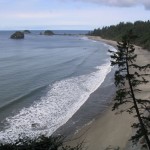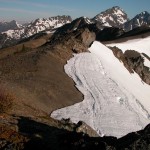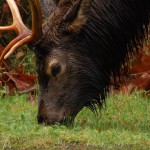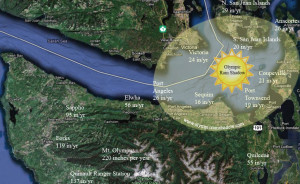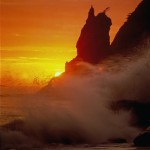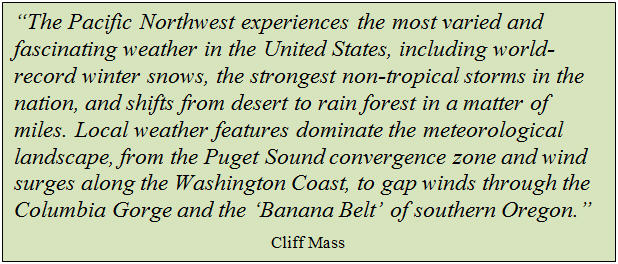
The Olympic Peninsula, and Olympic National Park in particular, is no exception to the above observation by Cliff Mass, author of The Weather of the Pacific Northwest. While on any given day the weather for the entire area may be similar—warm, wet, sunny, windy, cold, or rain—the intensity of the general condition can and often does vary dramatically.
Generally, air moving east off the ocean carries significant moisture from subtropical Pacific regions to the western reaches of Olympic National Park. Annual rainfall totals on the western Olympic Peninsula routinely exceed 140 inches and often approach 200 inches. The world’s greatest snowfall occurs on Mt. Olympus and the wettest snow on the planet falls on that mountain’s Blue Glacier.
The Park experiences two to four extreme weather events annually, characterized by torrential rains and high winds lasting several days. Fortunately these events usually happen between October and January when, with the exception of snow enthusiasts, few visitors are in the Park.
While the western reaches of the Park are the wettest, and the southern areas aren’t far behind, the northeast corner of the Park is the driest and extremely so. A curved line, drawn from Mt. Olympus to Victoria B.C., forms one edge of the “rain shadow”—an oval area with its ‘start’ on the northeast flanks of Mt. Olympus and its boundaries in or near the towns of Victoria, BC and Anacortes, WA to the north and Coupeville to the east. The town of Sequim lies well inside the south side of the rain shadow and enjoys the driest climate (an average of just under 17 inches of rain annually) of anywhere in western Washington.
While it can rain anytime, for the most part the rain is gentle and often best described as fat drizzle. In the wet months, October to April, expect some form of wet eight out of every ten days. In the dry months, May to September, it’s just the reverse.
The answer to the question “When is the best time to visit the Park?” depends on what you want to do or experience. There are exceptions, of course, but generally, you can:
- Experience the most intense Pacific storms on the coast in the fall and early winter.
- Enjoy cross-country skiing or snowshoeing in the abundant snow that is most common in January through March.
- See mountain wildflowers at the height of their bloom from the end of June into mid-July.
- Take advantage of the most snow-free hiking available in the deep backcountry from August to mid-October.
- Witness the Park’s waterfalls between October and August.
- View wildlife all year round if you’re quiet, patient and don’t try to get too close.
- Enjoy the area’s warmest and driest weather from mid-July to mid-September.
- Utilize the Park’s fully functioning facilities from June through October.
Hurricane Ridge is a popular site in the Park, and for good reason. It’s the only place that can be accessed year-round, where a large portion of the Park’s interior is visible, including Mt. Olympus. Due to weather and cost of operations the Hurricane Ridge Road is generally open only Fridays-Saturdays-Sundays from November through March. The road is open whether or not there is visibility at the top. Accessing the Park’s live ridge-cam (Hurricane Ridge Webcam) is a good idea and could save you time and frustration.
Summer days on the coast are often punctuated with morning fog, but make up for this with magnificent sunsets which don’t happen until after 9:00 pm in June and July. In summer bring fleece and light rain gear and in winter something more substantial to wear.
The links below provide annual weather information and predictions of variations (+) and (-) from normal for this year.
For normal weather conditions in the Park visit Weatherbase.com, and then navigate to the following cities in Washington:
- On the north, Port Angeles
- On the northwest, Forks
- On the southwest, Humptulips
- On the southeast Hoodsport
For current weather, visit the Weather Channel and search for the same cities.
For this year predictions of variations from the norm, visit the National Weather Service Climate Prediction Center, the Harris-Mann Climatology LongRangeWeather and the Weather Channel websites.

